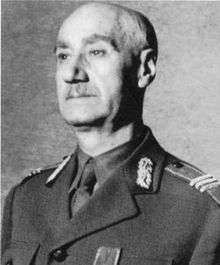Nicolae Rădescu
Nicolae Rădescu (Romanian pronunciation: [nikoˈla.e rəˈdesku]; 30 March 1874 – 16 May 1953) was a Romanian army officer and political figure. He was the last pre-communist rule Prime Minister of Romania, serving from 7 December 1944 to 1 March 1945.
Nicolae Rădescu | |
|---|---|
 | |
| 45th Prime Minister of Romania | |
| In office 7 December 1944 – 1 March 1945 | |
| Monarch | Michael I |
| Deputy | Petru Groza |
| Preceded by | Constantin Sănătescu |
| Succeeded by | Petru Groza |
| Chief of the Romanian General Staff | |
| In office 15 October 1944 – 6 December 1944 | |
| Monarch | Michael I |
| Preceded by | Gheorghe Mihail |
| Succeeded by | Constantin Sănătescu |
| Minister of Internal Affairs | |
| In office 14 December 1944 – 28 February 1945 | |
| Prime Minister | Himself |
| Preceded by | Constantin Sănătescu |
| Succeeded by | Teohari Georgescu |
| Personal details | |
| Born | March 30, 1874 Călimănești, Romania |
| Died | May 16, 1953 (aged 79) New York City, New York |
| Nationality | Romanian |
| Spouse(s) | Gizela Ettinger[1] |
| Children | Nicu Rădescu[1] |
| Profession | Military |
| Military service | |
| Allegiance | Kingdom of Romania |
| Branch/service | Romanian Land Forces |
| Rank | General de Corp de Armată (Lieutenant General) |
| Battles/wars | Second Balkan War World War I World War II |
Biography
Early life and education
The son of small landowners (Radu and Zamfira), Rădescu was born on 30 March 1874 in Călimănești, Vâlcea County. He attended the Military School for Officers, graduating on 1 July 1898 with the rank of second lieutenant. He pursued his military studies at the Cavalry School, graduating in June 1900 and being promoted to lieutenant in 1903, and then at the Higher War School in Bucharest (1904–1905), being promoted to captain on 4 October 1909.
Second Balkan War and World War I
In the summer of 1913 he saw action with the 1st Cavalry Division in the military campaign in Bulgaria during the Second Balkan War. He was promoted to major on 1 April 1916, and served in World War I during the Romanian Campaign of 1916 with the 5th Regiment Călărași. For his bravery and skill during the fighting with the German forces at the Carpathian mountain passes he was awarded on 10 January 1917 the Order of Michael the Brave, 3rd Class. In 1917 he was promoted to lieutenant colonel; he served as Chief of Staff for the 2nd Cavalry Division until 1 September 1918, and was promoted to colonel in 1919.[2]
The Interwar period
On 27 May 1920 Rădescu was appointed adjutant of King Ferdinand, after which he served as military attaché in London (1926–1928). Upon his return, he was promoted in March 1928 to brigadier general. He served as commanding officer of the 4th Brigade Roșiori, after which he was attached to the Inspectorate-General of Cavalry, and then commanded the 1st Cavalry Division (1931–1933). He resigned from the Army on 5 February 1933 and transferred to the retired reserves.[2] Upon presenting his resignation, he accused "profiteering politicians" and King Carol II's camarilla of commercializing military life.[3]
That same month Rădescu joined the People's Party of Marshal Alexandru Averescu. In the mid-1930s, he became involved in nationalist politics; he supported a far right movement called Cruciada Românismului ("The Crusade of Romanianism"), aimed at the cultural "Romanization" of Germans and Hungarians in Transylvania. This short-lived movement was a splinter group of the Iron Guard, created by Mihai Stelescu. After Stelescu was assassinated in July 1936 by an Iron Guard death squad, Rădescu became a leader of the movement, which quickly faded afterwards.[4] Because of his political stances and his opinions regarding the royal camarilla, he started being monitored by the secret police (Siguranța Statului).
World War II and the rise of Communism

After King Carol II abdicated in September 1940, Rădescu charged dictator Ion Antonescu with collaborating with the Nazis.[5] In 1942, Rădescu wrote an article critical of the German ambassador Manfred Freiherr von Killinger and his constant intrusion in the internal affairs of Romania. He was interned as a political prisoner in the Târgu Jiu camp. On 23 August 1944, immediately after Antonescu's downfall in King Michael's Coup, Rădescu was released from prison. On 15 October he was appointed Chief of the Romanian General Staff at the insistence of the Soviet government, which favored him for his independence and his reputation as an ardent anti-fascist who was respected by the people.[5]
He became prime minister on 7 December 1944. The Soviet government initially supported him; on a visit to Bucharest, the Deputy Foreign Minister, Andrey Vyshinsky, publicly expressed Soviet confidence in the Rădescu government. Soon after the situation changed, as conflicts over the armistice agreement emerged, especially over Moscow's demand $300 million in reparations; Rădescu also resisted the Soviet order to deport Germans from Romania to the Soviet Union.[5] He tried to adopt strong anti-Communist policies modeled on those of the George Papandreou Greek government. At the end of February 1945, the Communist Party of Romania and its allies organised a mass rally in front of the Royal Palace to call for his resignation. As the protest carried on, unknown persons opened fire from the Interior Ministry building situated across the street, killing some ten persons. Held responsible for this by the Soviets and the Romanian Communists, Rădescu was forced to resign. Vyshinsky, at the direction of Joseph Stalin, warned that the Soviet Union would not allow Northern Transylvania to be awarded back to Romania if Rădescu were to remain prime minister. He resigned his position on 1 March.
On 6 March 1945, the first Communist-dominated government of Romania took office under the direction of Petru Groza. Over the next few years, the Communists completely consolidated their power.
Exile in the West
In 1945, pursued by the Communist authorities, Rădescu sought refuge in the British legation, stayed there for about two months, and was then handed over to Romanian authorities, who had guaranteed his safety but placed him under house arrest.[1] In June 1946, he managed to flee on board a plane to the British Crown colony of Cyprus, where he was detained by the authorities until the Paris Peace Treaties were signed.[1] Via Lisbon and Paris he ended up in the United States.[1] Once in America, he and other exiled Romanian political figures, including Augustin Popa, Mihail Fărcășanu, Grigore Gafencu, and Constantin Vișoianu, came together to form a united anti-communist opposition in exile called the Romanian National Committee. In 1950, after disagreements within the Committee, he was one of the founders of the Liga Românilor Liberi ("The League of Free Romanians"), together with Grigore Gafencu, Nicolae Caranfil, Mihail Fărcășanu, Carol "Citta" Davila, Viorel V. Tilea, general Ion Gheorghe, and Vintilă Brătianu.[6]
Rădescu died on 16 May 1953 in New York City. At the initiative of Prime Minister Mugur Isărescu, the remains of General Rădescu were brought back to Romania in 2000. Following the wishes expressed in his testament, he was reburied at the Orthodox Bellu Cemetery in Bucharest on 23 November 2000.
References
- Demetriade, Oana (October 29, 2013). "Fiul împotriva tatălui. Securistul Nicu Rădescu vs. primul ministrul Nicolae Rădescu" (in Romanian). Revista 22. Archived from the original on July 23, 2014. Retrieved May 22, 2020.
- "Generals from Romania: Rădescu, Nicolae". generals.dk.
- Gheorghe, Constantin; Șerbu, Miliana (2007). Miniștrii de interne (1862–2007). Mică enciclopedie (PDF). Romanian Ministry of the Interior. ISBN 978-973-745-048-7.
- Stan, Marius (2012). History of Communism in Europe, Vol. 3: Communism, nationalism and state building in post-war Europe. Bucharest: Zeta Books. p. 45. ISBN 978-606-8266-27-5. OCLC 828818359.
- Vladimirov, Katya (2018-08-20). "General Nicolae Rădescu: New Sources, New Perspectives, 1940s–1950s". History. Wiley. 103 (357): 610–627. doi:10.1111/1468-229x.12626. ISSN 0018-2648.
- Kadar Lynn, Katalin, ed. (2013). The Inauguration of "Organized Political Warfare": The Cold War. Saint Helena, CA: Helena History Press. p. 151pp. ISBN 978-0-9859433-0-1. Retrieved July 18, 2014.
